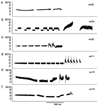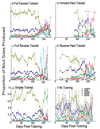Roles of syntax information in directing song development in white-crowned sparrows (Zonotrichia leucophrys)
- PMID: 20476811
- PMCID: PMC2874209
- DOI: 10.1037/a0017229
Roles of syntax information in directing song development in white-crowned sparrows (Zonotrichia leucophrys)
Abstract
Syntactical cues play an important role in song learning in songbirds. White-crowned sparrows (Zonotrichia leucophrys), whose song typically consists of four to five different phrases, fail to construct normal songs if exposed to all phrase types presented singly (Plamondon, Goller, & Rose, 2008; Soha & Marler 2001b). The specific role of acquired syntax information in guiding ontogenetic trajectories of syntax, however, and the respective contributions of instructive and selective processes to syntax ontogeny remain unknown. We tutored white-crowned sparrows with syntax information ranging from acoustic isolation to full song. Manipulation of tutor syntax influenced developmental trajectories of syntax assembly, suggesting that instructive processes contribute to syntax ontogeny. Early in development, birds tutored with full song or phrase pairs preferentially produced phrase pairings matching tutor syntax. Birds tutored with single phrases showed decreased diversity of pairwise syntactical combinations immediately after tutoring compared with other tutor groups, further illustrating the role of instructive processes. Overproduction of song material was also observed, suggesting that selective forces play a role in syntax development as well. Finally, consistent with the notion that innate influences guide syntax ontogeny, birds from all groups exhibited many similarities in trajectories of syntax assembly.
PsycINFO Database Record (c) 2010 APA, all rights reserved.
Figures











References
-
- Adret P. In search of the song template. In: Zeigler HP, Marler P, editors. Behavioural Neurobiology of Birdsong. New York: New York Academy of Sciences; 2004. pp. 303–324. - PubMed
-
- Adret P, Margoliash D. Metabolic and neural activity in the song system nucleus robustus archistriatalis: effect of age and gender. Journal of Comparative Neurology. 2002;454:409–423. - PubMed
-
- Armstrong EA. A study of bird song. London: Oxford University Press; 1963.
-
- Ball GF, Auger CJ, Bernard DJ, Charlier TD, Sartor JJ, Riters LV, Balthazart J. Seasonal plasticity in the song control system: multiple brain sites of steroid hormone action and the importance of variation in song behavior. Annals of the New York Academy of Sciences. 2004;1016:586–610. - PubMed
-
- Baptista LF. Wild house finch sings white-crowned sparrow song. Zeitschrift für Tierpsychologie. 1972;30:266–270.

